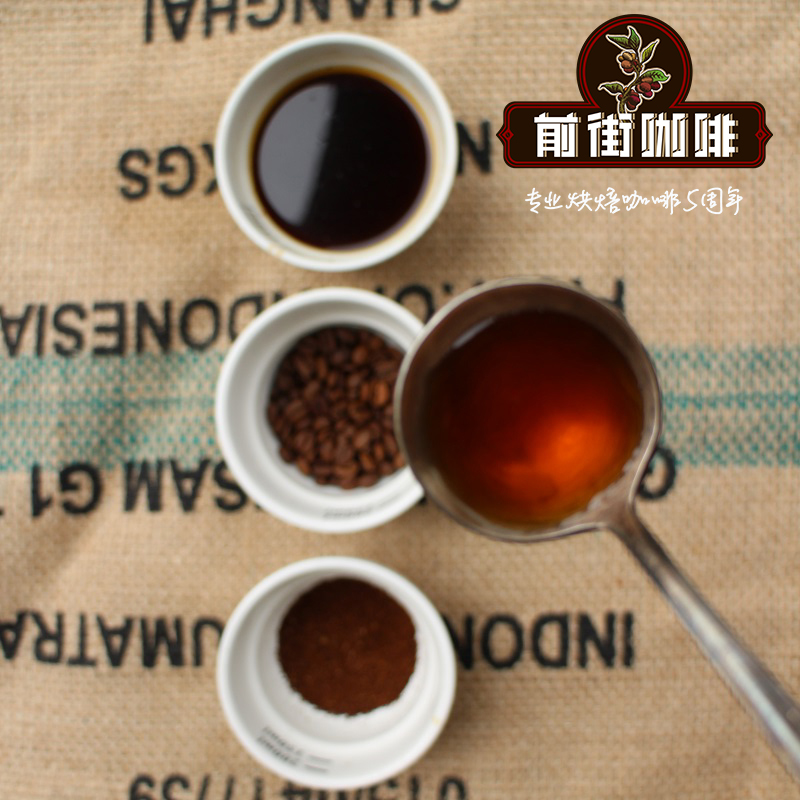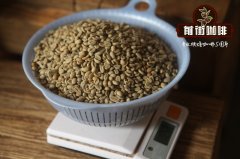What natural conditions are needed to grow high-quality coffee? How is the coffee fruit grown?

Professional coffee knowledge exchange more coffee bean information please follow the coffee workshop (Wechat official account cafe_style)
What natural conditions are needed to grow high-quality coffee fruits? How is the coffee fruit grown?
Coffee tree, is a tropical plant, is an evergreen shrub, growing in the equator, latitude 25 degrees north and south, that is, within the Tropic of Cancer. The Tropic of Cancer and near the equator are the coffee growing belts of the world. The growth conditions require abundant rainfall and humid climate, suitable elevation of about 600 Mel 1500 meters, annual rainfall of 1500 Mel 2000 mm, mild day and cool night alternating, the average annual temperature is about 15 Mel 25 degrees, and the temperature difference between day and night is about 10 degrees. The timing of rainfall is very important, it is best to have intervals of heavy rain and strong sunshine during maturity, and a period of dry weather is needed for harvest. Any form of soil is suitable, but the best soil is a mixture of decomposed volcanic soil, humic soil and permeable soil. The soil needs to be well drained. Although the coffee tree needs irrigation, pruning, weeding, fertilization and root protection, if the soil is not the best condition for the coffee tree, it will not bear fruit for several years. The sunshine time during the day is not very long, a few hours is enough. The hillside is an ideal location because of its short viewing time and good drainage. Coffee trees like wet roots, tall trees with most leaves planted in the coffee garden, on the one hand to protect against the wind, on the other hand shade. In terms of coffee tree disasters, frost and leaf diseases are the most common killers.
What conditions do you need to grow coffee trees?
Coffee is a perennial evergreen shrub or small tree of Rubiaceae. It is a horticultural perennial cash crop with the characteristics of fast growth, high yield, high value and wide market.
Wild coffee trees can grow to 5 to 10 Michael, but coffee trees planted on the manor are often cut to a height of less than 2 meters in order to increase fruit and facilitate harvesting.
Coffee tree opposite leaves are long oval, smooth leaves, the end of the branch is very long, few branches, and the flowers are white, open at the base of the petiole connecting the branch. The ripe coffee berries look like cherries and are bright red with sweet flesh and contain a pair of seeds, namely coffee beans (Coffee Beans).
Coffee varieties can be divided into small-grain, medium-grain and large-grain species, the former contains low caffeine content and strong flavor, while the latter two have high caffeine content but poor flavor. At present, coffee sold in the world is generally made of small and medium seeds in different proportions, usually 70% of medium seeds, mainly caffeine, and 30% of small seeds, mainly for their aroma. Each coffee variety generally has a few to a dozen variants. Coffee is more resistant to shade and cold, but not resistant to light, drought and disease. Coffee contains nine kinds of nutrients, such as caffeine, protein, crude fat, crude fiber and sucrose. As a beverage, coffee is not only mellow and delicious, slightly bitter and sweet, but also can excite nerves and dispel fatigue.
In medicine, caffeine can be used as an anesthetic, stimulant, diuretic and cardiotonic, as well as to help digestion and promote metabolism. The pulp of coffee is rich in sugar and can be used to make sugar and alcohol. Coffee flowers contain essential oils that can be used to extract high-grade spices.
The origin of the coffee tree is Ethiopia in Africa. In botany, coffee trees belong to the evergreen trees of the subgenus Rubiaceae, and coffee beans, commonly known as coffee beans, are the seeds of the fruit of coffee trees, just because they are shaped like beans, so they are called coffee beans.
Climate is the decisive factor for coffee cultivation. Coffee trees are only suitable for growing in the tropics or subtropics, so the zone between latitude 25 degrees south and north is the most suitable for growing coffee. This coffee production zone is generally referred to as "coffee belt" or "coffee area".
However, not all the land located in this area can cultivate good coffee trees. The ideal planting conditions for coffee trees are: a warm climate with a temperature of 15-25 ℃, and a rainfall of 1500-2000 mm throughout the year, and the rainfall time should be consistent with the flowering cycle of the coffee tree. Of course, in addition to the coordination of seasons and rainfall, there should be fertile soil. The most suitable soil for growing coffee is a well-drained, fertile soil containing volcanic ash.
In addition, although sunlight is an indispensable element for the growth and fruiting of coffee, too strong sunlight will affect the growth of coffee trees, so various producing areas will usually cooperate with the planting of some sunshade trees. generally plant higher trunk plants such as bananas, mangoes and legumes. The ideal altitude is 500-2000 meters above sea level. Therefore, the quality of Jamaican Blue Mountain coffee, which grows at an altitude of 8-1200 meters, is the best. It can be seen that the conditions for the cultivation of high-quality coffee are very strict: sunlight, rainfall, soil, air temperature, as well as the way coffee beans are harvested and the production process will affect the quality of coffee itself.
Flower and fruit
The first flowering period of the coffee tree is about three years old. the white five-petal tube-shaped flowers are filled with a faint scent of jasmine and the inflorescences are arranged in dense clusters. Flowers wither after two or three days of blooming and begin to bear fruit after a few months. The fruit is a drupe with a diameter of about 1.5cm. It turns green at first, then turns yellow gradually, and turns red when ripe. It is very similar to cherries, so it is called cherry coffee (Coffee Cherry). It can be harvested at this time.
Coffee fruit contains two seeds, namely coffee beans. The two beans are connected face to face with each other on one side of the plane. Each coffee bean has an outer membrane of pu, which is called silver skin, and its outer layer is covered with a yellow outer skin, called endocarp. The whole coffee bean is wrapped in a sticky pulp to form the coffee pulp, which is soft and sweet, with the outer shell.
Coffee tree belongs to the evergreen shrub of Rubiaceae, it is suitable for tropical growth, so the geographical environment of its cultivation is limited, coffee is afraid of frost, so the equator as the center line north and south latitude 25 degrees is the growth zone of coffee, the average annual temperature is 15 ℃ ~ 30 ℃ (high temperature above 30 ℃ will continue to hinder photosynthesis). The average annual rainfall of 1500 mm is the most suitable, the climate is cool, the mixed forest with shade is the best, and the soil is best in volcanic geology, latitude and altitude.
Can affect the quality of coffee. Gukeng Township is located at 23.5 degrees north latitude, while Hebao Mountain, Huashan, Guilin, Zhanghu and other tribes have an altitude of 300 Murray 800 Michael. The soil property is gneiss or boulder soil with good permeability, and the average annual temperature is between 15 ℃ and 28 ℃, the annual rainfall is more than 1500 mm, and the soil is evenly distributed between 3m and August, which is suitable for producing high quality organic coffee.
Many people have drunk coffee, but there are no more people who have seen coffee trees and coffee fruits than those who have drunk coffee. Coffee grows because it not only looks like beans, but also sprouts like it. The difference is that when beans sprout, they break through the seed coat from the navel of the beans and grow a single bean seedling, while coffee beans grow two coffee seedlings. After each seedling grows two green cotyledons around and spread out, it will grow up at the middle growing point. Coffee seedlings can be transplanted to the nursery for three months and can be planted annually. Shade planting was used in the province, but direct exposure is mostly used in Brazil.
Farmers and Coffee beans
Unshaded planting method. But the soil nutrients are quickly depleted. Therefore, fertilization should be strengthened, once a large number of coffee fruit, the harvest will be poor every other year, fertilization suggested the use of compound fertilizer No. 5, and the application of compound fertilizer No. 43 is better. Suitable for planting in volcanic soil, planting in the northeast can bear fruit earlier, but slowly in the southwest, coffee is beautiful and white flowers, Taiwan only blossoms once or twice and the same coffee tree blossoms at different times, green fruit and even white flowers can often be seen at the same time. This is a phenomenon of coffee trees, which increases the difficulty of harvesting. Most coffee trees are pollinated with white flowers, and they are very suitable for planting in large quantities.
Law. Because there is no need to attract bees to attract butterflies to transmit pollen, the distance between the planting plants on the hillside is 7 meters (1500 plants per armour). The average fruit of a coffee tree is 10 kilograms (5 years old). After deducting the weight of the flesh, only 1 kilograms of dried coffee beans can be harvested. The shading type has many advantages, which can prevent the coffee tree from growing slowly and the flavor is fully developed, but the quantity is small and the diseases and insect pests are reduced.
Important Notice :
前街咖啡 FrontStreet Coffee has moved to new addredd:
FrontStreet Coffee Address: 315,Donghua East Road,GuangZhou
Tel:020 38364473
- Prev

What are the conditions for growing coffee beans? How do you grow high-quality coffee beans?
Professional coffee knowledge exchange more coffee bean information please pay attention to the coffee workshop (Wechat official account cafe_style) what are the growing conditions of coffee beans? How do you grow high-quality coffee beans? Many people think that Taiwan is not suitable for growing coffee, or that it is impossible for Taiwan to grow good coffee. The so-called good coffee refers to high quality coffee. Coffee cultivation and quality factors, except
- Next

How do you grow coffee beans? What kind of planting environment is needed for excellent coffee fruit? How to correct
Professional coffee knowledge exchange more coffee bean information please follow the coffee workshop (Wechat official account cafe_style) how to grow coffee beans? What kind of planting environment is needed for excellent coffee fruit? How to cultivate and plant correctly? Due to the physiological characteristics of coffee trees, there are limited areas in the world that can cultivate coffee beans commercially. It is mainly limited by temperature.
Related
- Detailed explanation of Jadeite planting Land in Panamanian Jadeite Manor introduction to the grading system of Jadeite competitive bidding, Red bid, Green bid and Rose Summer
- Story of Coffee planting in Brenka region of Costa Rica Stonehenge Manor anaerobic heavy honey treatment of flavor mouth
- What's on the barrel of Blue Mountain Coffee beans?
- Can American coffee also pull flowers? How to use hot American style to pull out a good-looking pattern?
- Can you make a cold extract with coffee beans? What is the right proportion for cold-extracted coffee formula?
- Indonesian PWN Gold Mandrine Coffee Origin Features Flavor How to Chong? Mandolin coffee is American.
- A brief introduction to the flavor characteristics of Brazilian yellow bourbon coffee beans
- What is the effect of different water quality on the flavor of cold-extracted coffee? What kind of water is best for brewing coffee?
- Why do you think of Rose Summer whenever you mention Panamanian coffee?
- Introduction to the characteristics of authentic blue mountain coffee bean producing areas? What is the CIB Coffee Authority in Jamaica?

